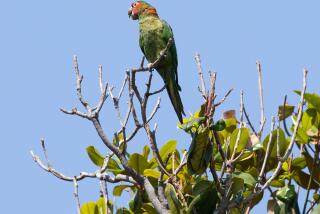Clever Inventor Gets the Drop on Harbor Pigeons
- Share via
In the clean, orderly workshop where he has tinkered since World War II, Vic Chatten has invented a contraption that he thinks is going to make the Los Angeles Harbor Department very happy.
It will not increase revenues, nor will it ease the workload or improve efficiency.
But it will make the pigeons go away.
He calls it “the bird barrier.” On Tuesday, Harbor Department officials installed about 500 feet of it on part of their San Pedro headquarters, which has served as a nesting place for hundreds of pesky pigeons since it opened in 1981.
That same year, the building won a prestigious American Institute of Architects award for its unusual design of exposed girders and trusses that mimic the huge cranes at the Port of Los Angeles.
‘Perfect Bird Roost’
Award or no award, the building “was designed as a perfect bird roost,” complains facilities manager Don Williams, noting that the girders provide the birds with plenty of good landing space.
“The architect that designed the thing, I’m willing to bet, had absolutely no thought about the bird problem. . . . The first day we moved in, we had birds you wouldn’t believe.”
The bird barrier is remarkably simple. It looks like the Slinky toy: a thin metal coil, fastened to a long, narrow metal bar that Chatten attaches to rooftops, ledges or wherever birds perch. The pigeons find it too wobbly to land on and, unlike mass-marketed pigeon preventers that use barbs, it doesn’t hurt the feathered fiends, Chatten says.
Williams has tried for years to get rid of the birds, which have a way of leaving their white splotches in the most unwanted places--in this case, on the cars of Harbor Department employees, who sometimes must step across 12-foot slicks of pigeon droppings that blanket their open-air parking garage.
Although the pigeons flock to the entire building, their favorite nesting spot is among the girders above the second floor of the garage, and that is where the bird barrier was placed Tuesday. The tops of the beams were covered with coils, which, because of their thinness, are barely noticeable.
Past efforts to get rid of the pigeons have been unsuccessful. Williams says trapping them doesn’t work; county officials snared about 300 birds, but others showed up. Chicken wire helped a little on the roof--”we don’t have the pigeon stuff streaking down the windows like it had been before”--but it tends to rust and must be bunched up to be effective, making it of little use on the narrow beams favored by the birds.
Enter Chatten, a former Hollywood stunt man and deep sea diver who, these last 40 years, has worked at what he calls “research and development” in the garage-turned-workshop behind his house in Los Angeles’ Harbor Gateway district just east of Torrance.
At age 75, Chatten says he is retired from his company, Patented Products Inc., but he shows no signs of slowing down. “I’ll probably stop this whole damn thing when I get to Forest Lawn,” he jokes. “You can’t work out of there.”
He putters around his workshop--its walls lined with neat rows of screwdrivers, clamps and other tools--in spotless blue coveralls. His house is dotted with his creations: a water-powered clock; a lamp with strands of crystals that rotate around its stem; a security system in which an infrared monitor triggers four floodlights if anyone gets within 40 feet of the house after sundown. The security device recently went off for the first time, Chatten said, when “a damned cat” jumped on his car.
Something for the Cook
In the kitchen, there’s a “garlic injector,” which spreads the taste of a clove evenly through a roast. Chatten tried to market that one in the 1960s for 29 cents, but it didn’t catch on.
Other projects did. The beach sanitizer, a 16-ton sand-cleaning machine he invented in the late 1940s and named Louise, after his former wife, earned Chatten a write-up in Life magazine. The WonderFall, a fountain that simulates rainfall with droplets that descend along invisible nylon line, graces shopping malls as far away as Tokyo.
Although his inventions have not made him rich, he says he has not had to work a 9-to-5 job since he served as a navigating officer for American President Lines in the late 1940s.
Now, he says, he is negotiating with a manufacturer to mass-produce the bird barrier. He invented it a couple of years ago to combat a pigeon problem at La Costa, where he owns a condominium, but it wasn’t until last year, when he read a newspaper account of the Harbor Department’s problem, that he decided there was “a dire need” for his latest problem-solver.
On his own, Chatten has installed the bird barrier at the prospective manufacturer’s headquarters, at Sea World in San Diego, where officials say it “seems to be doing the trick,” and at the fish market the Harbor Department runs in San Pedro. He charges $2 a foot, considerably less, he says, than conventional barbed barriers.
The Harbor Department’s Williams was happy to pay $1,000 to drive away the pigeons, although he says one thing concerns him. Now that the garage is off-limits, he figures, “these pigeons are going to look around and their beady little eyes are going to find another part of the building.” Perhaps the whole building will have to be pigeon-proofed.
As for Harbor Department employees, Williams says, all they want are the simple things in life, like “a car that isn’t festooned with pigeon droppings.”
More to Read
Sign up for Essential California
The most important California stories and recommendations in your inbox every morning.
You may occasionally receive promotional content from the Los Angeles Times.










